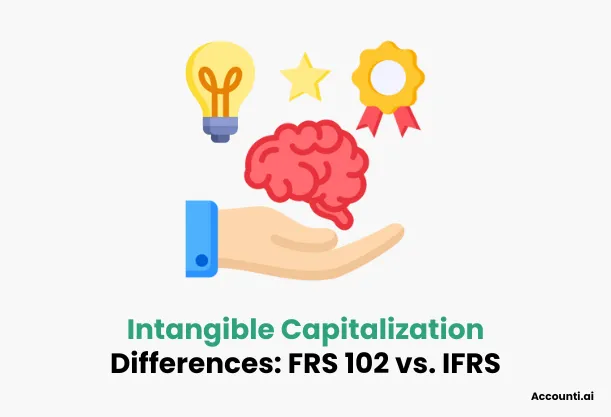
Difference in Intangible Capitalisation Between FRS 102 and IFRS
When it comes to financial reporting, understanding the treatment of intangible assets is crucial for businesses. Two major accounting frameworks, FRS 102 and IFRS, handle intangible capitalization differently. These distinctions can significantly affect how businesses present their financial position and performance. Let’s dive deep into the differences and what they mean for your business.
What is Intangible Capitalization?
Intangible capitalization refers to the process of recognizing intangible assets on the balance sheet instead of expensing them immediately.
What are Intangible Assets?
Intangible assets are non-physical, long-term assets that have value. Examples include:
- Patents
- Trademarks
- Goodwill
- Customer lists
- Software
These assets can provide economic benefits to businesses over time, making their proper capitalization essential for accurate financial reporting.
Why is it Important?
The capitalization of intangible assets ensures:
- Accurate reflection of the company’s financial health.
- Better comparability with other entities.
- Compliance with accounting standards.
What is FRS 102?
FRS 102, also known as the Financial Reporting Standard applicable in the UK and Republic of Ireland, is a simplified accounting framework tailored for small to medium-sized entities. It draws from international standards but incorporates specific adjustments for these markets.
What is IFRS?
The International Financial Reporting Standards (IFRS) are globally accepted accounting standards aimed at providing transparency, accountability, and efficiency in financial markets. IFRS is widely used by large and publicly listed companies.
Key Differences in Intangible Capitalization
Understanding the differences between FRS 102 and IFRS regarding intangible capitalization is essential for compliance and effective financial reporting. Below are the main distinctions:
1. Recognition Criteria
- FRS 102: Intangible assets are recognized only if it is probable that future economic benefits will flow to the entity and the cost of the asset can be measured reliably.
- IFRS: Similar recognition criteria apply, but IFRS includes more detailed guidance, particularly under IAS 38, for identifying and measuring intangible assets.
2. Measurement and Valuation
- FRS 102: Intangible assets are initially measured at cost. Fair value measurements are not commonly applied, except in specific circumstances like business combinations.
- IFRS: Intangibles are measured at either cost or fair value. IFRS allows revaluation of intangibles to reflect their current market value, provided there is an active market.
3. Subsequent Measurement
- FRS 102: Amortization is mandatory for all intangibles unless their useful life cannot be determined reliably, in which case it is capped at 10 years.
- IFRS: Requires amortization for finite-life intangibles, while indefinite-life intangibles (e.g., goodwill) are subject to annual impairment testing instead of amortization.
4. Research and Development Costs
- FRS 102: Research costs are expensed, while development costs can be capitalized if certain conditions are met.
- IFRS: Similar rules apply under IAS 38, but IFRS provides more comprehensive guidance on assessing the technical and financial feasibility of development projects.
Impact on Businesses
1. Financial Reporting Implications
The way intangible assets are capitalized affects key financial metrics like net income, total assets, and equity. IFRS’s allowance for revaluation often results in higher asset values compared to FRS 102.
2. Taxation and Compliance
Capitalization rules influence taxable income and compliance requirements. IFRS-compliant businesses may face additional scrutiny during audits due to the complexities of fair value measurements.
3. Business Decisions
The choice between FRS 102 and IFRS impacts mergers, acquisitions, and investor decisions. IFRS tends to offer greater transparency for stakeholders in global markets.
Feature Comparison of FRS 102 & IFRS
|
Feature |
FRS 102 |
IFRS |
|
Recognition Criteria |
Probable economic benefit, measurable cost |
Probable benefit, detailed IAS 38 guidance |
|
Initial Measurement |
Cost-based |
Cost or fair value |
|
Subsequent Measurement |
Amortization mandatory |
Amortization or impairment testing |
|
Revaluation Option |
Rare |
Allowed with active market |
|
Research Costs |
Expensed |
Expensed |
|
Development Costs |
Conditional capitalization |
Conditional capitalization |
Pros and Cons of Each Approach
FRS 102
- Pros:
- Simplified framework.
- Ideal for small and medium businesses.
- Easier compliance for non-global entities.
- Cons:
- Limited scope for fair value adjustments.
- Conservative approach may undervalue assets.
IFRS
- Pros:
- Greater transparency and comparability.
- Flexibility to revalue assets.
- Globally recognized.
- Cons:
- Complex requirements.
- Higher compliance and audit costs.
Conclusion
Understanding the differences between FRS 102 and IFRS in intangible capitalization is essential for businesses navigating financial reporting. While FRS 102 offers simplicity and ease for smaller entities, IFRS provides a robust framework with flexibility for large, global organizations. Ultimately, the choice depends on your business size, industry, and reporting needs.
FAQs
What is the difference between FRS 102 and IFRS business combinations?
FRS 102 and IFRS have distinct approaches to business combinations:
- Transaction Costs: Under FRS 102, direct acquisition costs, such as legal fees, are capitalized as part of the acquisition cost. In contrast, IFRS requires these costs to be expensed as incurred.
- Intangible Assets Recognition: Both standards mandate the recognition of identifiable intangible assets at fair value during a business combination. However, IFRS provides more detailed guidance on identifying and measuring these assets.
- Goodwill Treatment: FRS 102 requires amortization of goodwill over its useful life, with a presumed maximum of 10 years if the life cannot be reliably estimated. Conversely, IFRS does not permit amortization of goodwill but mandates annual impairment testing.
How are intangible assets valued in IFRS?
Under IFRS, intangible assets are initially recognized at cost. Post-acquisition, entities can choose between:
- Cost Model: Carrying the asset at cost less accumulated amortization and impairment losses.
- Revaluation Model: Carrying the asset at its fair value at the revaluation date, less any subsequent amortization and impairment losses. This model is applicable only if fair value can be determined by reference to an active market.
It's important to note that active markets for intangible assets are uncommon, making the revaluation model less frequently used.
What costs can be capitalized under IFRS?
IFRS allows capitalization of costs directly attributable to preparing an asset for its intended use, including:
- Purchase Price: Including import duties and non-refundable taxes, after deducting trade discounts and rebates.
- Directly Attributable Costs: Such as employee benefits arising directly from bringing the asset to its working condition, costs of site preparation, and initial delivery and handling costs.
General administrative and overhead costs are typically expensed as incurred and not capitalized.
What costs can be capitalized for intangible assets?
For intangible assets, IFRS permits capitalization of:
- Directly Attributable Expenditures: Costs necessary to create, produce, and prepare the asset to be capable of operating in the manner intended by management.
Expenditures on research are expensed when incurred, while development costs can be capitalized if specific criteria are met, such as technical feasibility and the intention to complete the asset for use or sale.
How should intangible assets be valued?
Intangible assets should be valued based on:
- Initial Recognition: At cost, encompassing purchase price and any directly attributable costs.
- Subsequent Measurement: Using either the cost model or, if an active market exists, the revaluation model.
Regular impairment reviews are essential, especially for assets with indefinite useful lives, to ensure carrying amounts do not exceed recoverable amounts.
By comprehending these distinctions and valuation methods, entities can ensure compliance with relevant standards and present a true and fair view of their financial position.

 Rohit Kapoor
Rohit Kapoor

